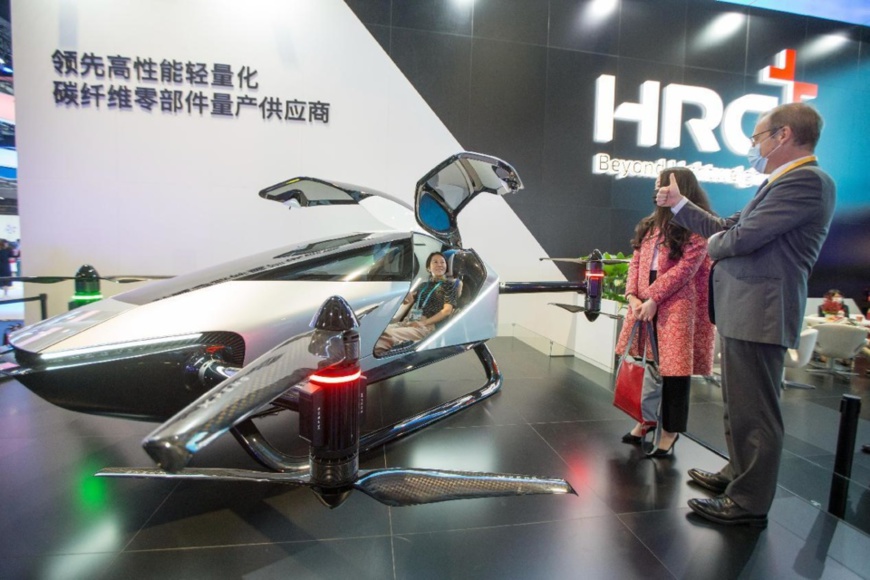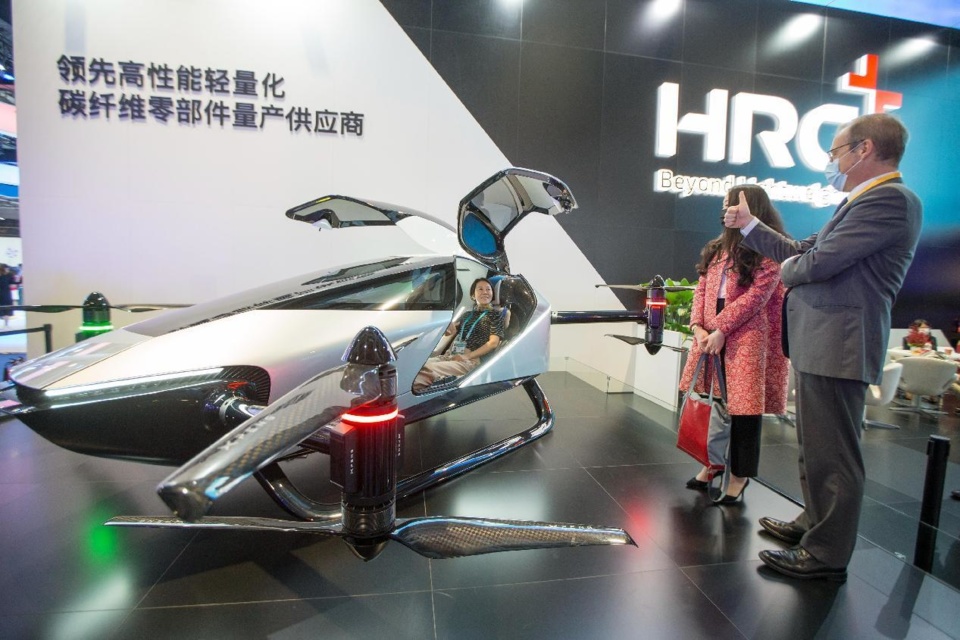By Wang Zheng, People’s Daily

The X2, a flying car from Chinese electric vehicle producer XPeng, is exhibited at the automobile section of the fourth China International Import Expo, Nov. 6, 2021. (Photo by Zhai Huiyong/People’s Daily Online)
Recently, an Australian consumer joined a two-week test driving activity held for MG ZS, a pure electric vehicle (EV) model produced by Chinese automaker SAIC Motor. The long range and safety performance of the Chinese EV impressed her very much.
Overseas users are paying an increasingly higher attention on China-produced vehicles as Chinese auto brands appear more and more on the international market.
“The era for Chinese auto manufacturing has arrived,” said Yu De, managing director of SAIC Motor International Business Department.
According to the latest statistics released by China Association of Automobile Manufacturers (CAAM), Chinese automakers exported a new high of 249,000 vehicles in June this year, registering a monthly growth of 1.8 percent and a year-on-year growth of 57.4 percent. In the first half of 2022, China’s auto exports rose 47.1 percent year on year to nearly 1.22 million units.
The exports of new energy vehicles (NEVs) have embraced explosive growth since 2021. Last year, the country exported 310,000 NEVs, three times of those from a year ago. The figure stood at 202,000 in the first six months of 2022, expanding 1.3 times year on year.
Quality and brand influence are what make Chinese automakers more and more accepted in developed countries.
At present, mainstream Chinese automakers are completely capable of independently developing finished automobiles, chassis, engines and gears. China is a leading player globally in the area of power battery. The average range of EVs in the country has been raised to over 400 km. Twenty percent of the vehicles being sold on the Chinese market are equipped with combined driver assistance system.
Last year, Chinese enterprises were authorized over 30,000 patents related to NEV, which accounted for 70 percent of the world’s total.
With an increasingly complete industrial chain in the auto industry, China has established the world’s largest, most complete and best supported industrial system for the sector. The country has deeply integrated itself into the global supply ecology, becoming an important production and supply center of automobiles.
Chinese automakers tailor different products and services for different markets. For instance, engineers from SAIC Motors lifted the ride height of vehicles in countries with poor road conditions, and Changan Automobile has developed new technologies that are able to heat battery packs from −30 °C to -10 °C in five minutes, which ensures the acceleration and charging performance of EVs in extremely cold environment.
“Nio’s battery swapping technology gives me a great user experience. I’d like to try more of the brand’s models in the future,” said a man surnamed Birkenfeld, who was among the first batch of consumers in Oslo, capital of Norway to receive the Chinese EV maker’s ES8 model.
“A total of more than 5,000 EVs were sold in Australia and 27 percent of them were produced by SAIC MG,” Yu said. The SAIC Motor now has a complete product line in terms of NEVs after three years of development in pure EVs, plug-in hybrid EVs and hydrogen cell vehicles.
“New energy and smart connection are accelerating Chinese automakers’ overseas expansion,” he told People’s Daily.
“The first-mover advantage of Chinese automakers in new energy and smart connection is bringing a change in European consumers’ perception of Chinese brands,” said Sun Bing, a senior executive in charge of the operations of Great Wall Motors in Europe.
Europe is becoming a major incremental market for China’s auto exportation. According to Chinese customs, China’s auto exports to Europe more than doubled last year, and developed countries including Belgium, the UK, Germany and France were leading in the top-ten European destinations of Chinese NEVs.
Many European consumers and business partners believe China is leading a new trend of development in the auto industry in terms of electrification and intelligentization, Sun noted.
To take the opportunity of the global transformation in the auto industry and build a new image of Chinese auto brands is a test to Chinese automakers’ wisdom.
“China’s mainstream brands will further raise their competitiveness in the Chinese market and even the world at large, said Zhu Huarong, rotating chairman of CAAM. He believes world-class Chinese auto brands will be born in the next decade.
Overseas users are paying an increasingly higher attention on China-produced vehicles as Chinese auto brands appear more and more on the international market.
“The era for Chinese auto manufacturing has arrived,” said Yu De, managing director of SAIC Motor International Business Department.
According to the latest statistics released by China Association of Automobile Manufacturers (CAAM), Chinese automakers exported a new high of 249,000 vehicles in June this year, registering a monthly growth of 1.8 percent and a year-on-year growth of 57.4 percent. In the first half of 2022, China’s auto exports rose 47.1 percent year on year to nearly 1.22 million units.
The exports of new energy vehicles (NEVs) have embraced explosive growth since 2021. Last year, the country exported 310,000 NEVs, three times of those from a year ago. The figure stood at 202,000 in the first six months of 2022, expanding 1.3 times year on year.
Quality and brand influence are what make Chinese automakers more and more accepted in developed countries.
At present, mainstream Chinese automakers are completely capable of independently developing finished automobiles, chassis, engines and gears. China is a leading player globally in the area of power battery. The average range of EVs in the country has been raised to over 400 km. Twenty percent of the vehicles being sold on the Chinese market are equipped with combined driver assistance system.
Last year, Chinese enterprises were authorized over 30,000 patents related to NEV, which accounted for 70 percent of the world’s total.
With an increasingly complete industrial chain in the auto industry, China has established the world’s largest, most complete and best supported industrial system for the sector. The country has deeply integrated itself into the global supply ecology, becoming an important production and supply center of automobiles.
Chinese automakers tailor different products and services for different markets. For instance, engineers from SAIC Motors lifted the ride height of vehicles in countries with poor road conditions, and Changan Automobile has developed new technologies that are able to heat battery packs from −30 °C to -10 °C in five minutes, which ensures the acceleration and charging performance of EVs in extremely cold environment.
“Nio’s battery swapping technology gives me a great user experience. I’d like to try more of the brand’s models in the future,” said a man surnamed Birkenfeld, who was among the first batch of consumers in Oslo, capital of Norway to receive the Chinese EV maker’s ES8 model.
“A total of more than 5,000 EVs were sold in Australia and 27 percent of them were produced by SAIC MG,” Yu said. The SAIC Motor now has a complete product line in terms of NEVs after three years of development in pure EVs, plug-in hybrid EVs and hydrogen cell vehicles.
“New energy and smart connection are accelerating Chinese automakers’ overseas expansion,” he told People’s Daily.
“The first-mover advantage of Chinese automakers in new energy and smart connection is bringing a change in European consumers’ perception of Chinese brands,” said Sun Bing, a senior executive in charge of the operations of Great Wall Motors in Europe.
Europe is becoming a major incremental market for China’s auto exportation. According to Chinese customs, China’s auto exports to Europe more than doubled last year, and developed countries including Belgium, the UK, Germany and France were leading in the top-ten European destinations of Chinese NEVs.
Many European consumers and business partners believe China is leading a new trend of development in the auto industry in terms of electrification and intelligentization, Sun noted.
To take the opportunity of the global transformation in the auto industry and build a new image of Chinese auto brands is a test to Chinese automakers’ wisdom.
“China’s mainstream brands will further raise their competitiveness in the Chinese market and even the world at large, said Zhu Huarong, rotating chairman of CAAM. He believes world-class Chinese auto brands will be born in the next decade.
 Menu
Menu
 China’s auto exports on fast growth
China’s auto exports on fast growth
















